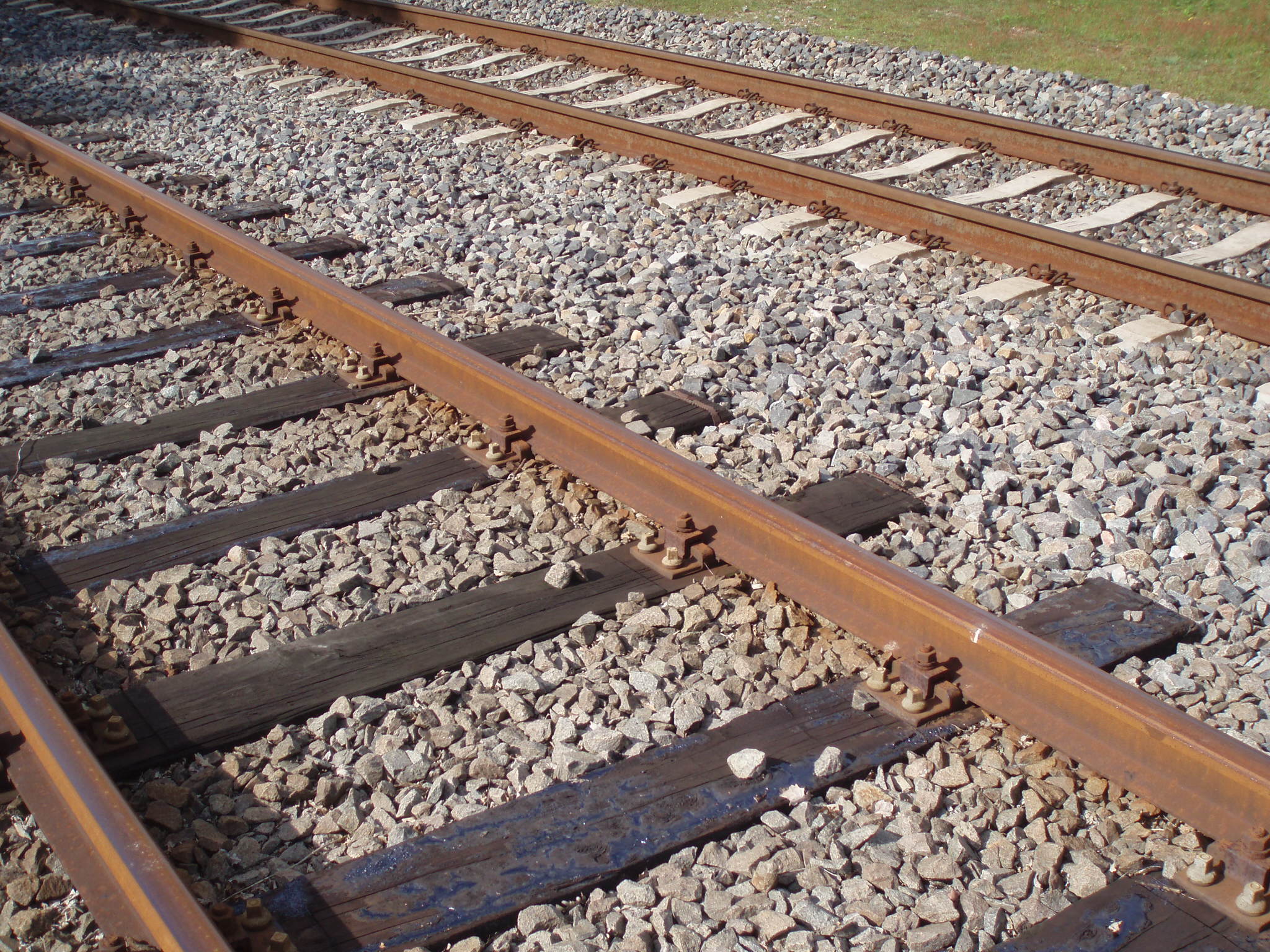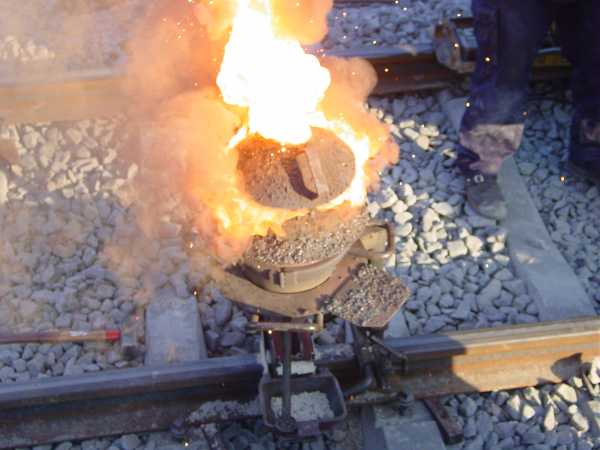|
Fishplate UK 2006
A fishplate joins two lengths of track. A fishplate, splice bar or joint bar is a metal or composites connecting plate used to bolt the ends of two rails into a continuous track. The name is derived from ''fish'', a wooden reinforcement of a "built-up" ship's mast that helped round out its desired profile. The top and bottom faces taper inwards along their short dimensions to create an even alignment between the two rails when the fish plate is wedged into place by tightening its bolts during installation. In rail transport modelling, a fishplate is often a small copper or nickel silver plate that slips onto both rails to provide the functions of maintaining alignment and electrical continuity. History The device was invented by William Bridges Adams in May 1842, because of his dissatisfaction with the scarf joints and other systems of joining rails then in use. He noted that to form the scarf joint the rail was halved in thickness at its ends, where the stress was great ... [...More Info...] [...Related Items...] OR: [Wikipedia] [Google] [Baidu] |
Track Circuit
A track circuit is an electrical device used to prove the absence of a train on a block of rail tracks to control railway signals. An alternative to track circuits are axle counters. Principles and operation The basic principle behind the track circuit lies in the connection of the two rails by the wheels and axle of locomotives and rolling stock to short an electrical circuit. This circuit is monitored by electrical equipment to detect the absence of the trains. Since this is a safety appliance, fail-safe operation is crucial. Hence the circuit is designed to indicate the presence of a train when failures occur. On the other hand, false occupancy readings are disruptive to railway operations and must be minimized. Track circuits allow railway signalling systems to operate semi-automatically, by displaying signals for trains to slow or stop in the presence of occupied track ahead of them. They help prevent dispatchers and operators from causing accidents, both by informin ... [...More Info...] [...Related Items...] OR: [Wikipedia] [Google] [Baidu] |
Permanent Way
Railway track ( and International Union of Railways, UIC terminology) or railroad track (), also known as permanent way () or "P way" ( and English in the Commonwealth of Nations#Indian subcontinent, Indian English), is the structure on a Rail transport, railway or railroad consisting of the Rail profile, rails, Rail fastening system, fasteners, sleepers (railroad ties in American English) and Track ballast, ballast (or Ballastless track, slab track), plus the underlying subgrade. It enables trains to move by providing a dependable, low-friction surface on which steel wheels can roll. Early tracks were constructed with wooden or cast-iron rails, and wooden or stone sleepers. Since the 1870s, rails have almost universally been made from steel. Historical development The first railway in Britain was the Wollaton wagonway, built in 1603 between Wollaton and Strelley in Nottinghamshire. It used wooden rails and was the first of about 50 wooden-railed Tramway (industrial), tram ... [...More Info...] [...Related Items...] OR: [Wikipedia] [Google] [Baidu] |
Tie Plate
A rail fastening system is a means of fixing rails to railroad ties (North America) or sleepers (British Isles, Australasia, and Africa). The terms ''rail anchors'', ''tie plates'', ''chairs'' and ''track fasteners'' are used to refer to parts or all of a rail fastening system. The components of a rail fastening system may also be known collectively as other track material, or OTM for short. Various types of fastening have been used over the years. History and overview The earliest wooden rails were fixed to wooden sleepers by pegs through holes in the rail, or by nails. By the 18th century, cast iron rails had come into use, and also had holes in the rail itself to allow them to be fixed to a support. 18th century developments such as the flanged rail and fish bellied rail also had holes in the rail itself; when stone block sleepers were used the nails were driven into a wooden block which had been inserted into a recess in the block. The first chair for a rail is thought to ... [...More Info...] [...Related Items...] OR: [Wikipedia] [Google] [Baidu] |
Rail Lengths
Rail or rails may refer to: Rail transport *Rail transport and related matters *Railway track or railway lines, the running surface of a railway Arts and media Film * ''Rails'' (film), a 1929 Italian film by Mario Camerini * ''Rail'' (1967 film), a film by Geoffrey Jones for British Transport Films * ''Rail'' (2024 film), a Tamil-language film Magazines * ''Rail'' (magazine), a British rail transport periodical * ''Rails'' (magazine), a former New Zealand based rail transport periodical Other arts *The Rails, a British folk-rock band * Rail (theater) or batten, a pipe from which lighting, scenery, or curtains are hung Technology *Rails framework or Ruby on Rails, a web application framework *Rail system (firearms), a mounting system for firearm attachments *Front engine dragster *Runway alignment indicator lights, a configuration of an approach lighting system *Rule Augmented Interconnect Layout, a specification for expressing guidelines for printed circuit boards; companion ... [...More Info...] [...Related Items...] OR: [Wikipedia] [Google] [Baidu] |
Railroad Tie
A railroad tie, crosstie (American English), railway tie (Canadian English) or railway sleeper ( Australian and British English) is a rectangular support for the rails in railroad tracks. Generally laid perpendicular to the rails, ties transfer loads to the track ballast and subgrade, hold the rails upright and keep them spaced to the correct gauge. Railroad ties are traditionally made of wood, but prestressed concrete is now also widely used, especially in Europe and Asia. Steel ties are common on secondary lines in the UK; plastic composite ties are also employed, although far less than wood or concrete. As of January 2008, the approximate market share in North America for traditional and wood ties was 91.5%, the remainder being concrete, steel, azobé (red ironwood) and plastic composite. Tie spacing may depend on the type of tie, traffic loads and other requirements, for example on North American mainline railroads to on London, Midland and Scottish Railway joi ... [...More Info...] [...Related Items...] OR: [Wikipedia] [Google] [Baidu] |
British Railways
British Railways (BR), which from 1965 traded as British Rail, was a state-owned company that operated most rail transport in Great Britain from 1948 to 1997. Originally a trading brand of the Railway Executive of the British Transport Commission, it became an independent statutory corporation in January 1963, when it was formally renamed the British Railways Board. British Railways was formed on 1 January 1948 as a result of the Transport Act 1947, which nationalisation, nationalised the Big Four (British railway companies), Big Four British railway companies along with some other (but not all) smaller railways. Profitability of the railways became a pressing concern during the 1950s, leading to multiple efforts to bolster performance, including some line closures. The History of rail transport in Great Britain 1948–1994#The Modernisation Plan, 1955 Modernisation Plan formally directed a process of dieselisation and Railway electrification in Great Britain, electrification ... [...More Info...] [...Related Items...] OR: [Wikipedia] [Google] [Baidu] |
Hither Green Rail Crash
On 5 November 1967, a busy Sunday evening train service from to derailed near the Hither Green maintenance depot in London, between and railway stations. Of the twelve coaches, many full of standing passengers, eleven were derailed and four turned onto their sides, resulting in 49 fatalities and 78 injuries. It is Britain's sixth worst rail disaster in terms of death toll. The derailment was found to be due to a broken rail. The Ministry of Transport report criticised the maintenance of the line, especially following a recent increase of the maximum speed of trains over the route. Following the accident the maintenance of the line was improved and plans accelerated for replacing jointed track by continuous welded rail. Derailment On Sunday 5 November 1967 the 19:43 Hastings to Charing Cross service, consisting of twelve coaches formed by two six-car diesel-electric multiple units – 1007 (a 6S) leading 1017 (a 6L) – and travelling at approximately , derailed at 21 ... [...More Info...] [...Related Items...] OR: [Wikipedia] [Google] [Baidu] |
Flash Welding
Flash welding is a type of resistance welding that does not use any filler metals. The pieces of metal to be welded are set apart at a predetermined distance based on material thickness, material composition, and desired Material properties, properties of the finished weld. Electrical current, Current is applied to the metal, and the gap between the two pieces creates Electrical resistance and conductance, resistance and produces the Electric arc, arc required to melt the metal. Once the pieces of metal reach the proper temperature, they are pressed together, effectively forge welding them together. Parameters According to a study published in Materials and Design, several parameters affect the final product. Flash time is the time that the Electric arc, arc is present. Upset time is the amount of time that the two pieces are pressed together. Flash time needs to be long enough to sufficiently heat the metal before it is pressed together. However, if it is too long, too much of ... [...More Info...] [...Related Items...] OR: [Wikipedia] [Google] [Baidu] |
Thermite Welding
Exothermic welding, also known as exothermic bonding, thermite welding (TW), and thermit welding, is a welding process that employs molten metal to permanently join the conductors. The process employs an exothermic reaction of a thermite composition to heat the metal, and requires no external source of heat or current. The chemical reaction that produces the heat is an aluminothermic reaction between aluminium powder and a metal oxide. Overview In exothermic welding, aluminium dust reduces the oxide of another metal, most commonly iron oxide, because aluminium is highly reactive. Iron(III) oxide is commonly used: :\mathrm The products are aluminium oxide, free elemental iron, and a large amount of heat. The reactants are commonly powdered and mixed with a binder to keep the material solid and prevent separation. Commonly the reacting composition is five parts iron oxide red (rust) powder and three parts aluminium powder by weight, ignited at high temperatures. A strongly ... [...More Info...] [...Related Items...] OR: [Wikipedia] [Google] [Baidu] |
Electric Traction
Railway electrification is the use of electric power for the propulsion of rail transport. Electric railways use either electric locomotives (hauling passengers or freight in separate cars), electric multiple units (passenger cars with their own motors) or both. Electricity is typically generated in large and relatively efficient generating stations, transmitted to the railway network and distributed to the trains. Some electric railways have their own dedicated generating stations and transmission lines, but most purchase power from an electric utility. The railway usually provides its own distribution lines, switches, and transformers. Power is supplied to moving trains with a (nearly) continuous conductor running along the track that usually takes one of two forms: an overhead line, suspended from poles or towers along the track or from structure or tunnel ceilings and contacted by a pantograph, or a third rail mounted at track level and contacted by a sliding "pickup shoe". B ... [...More Info...] [...Related Items...] OR: [Wikipedia] [Google] [Baidu] |






